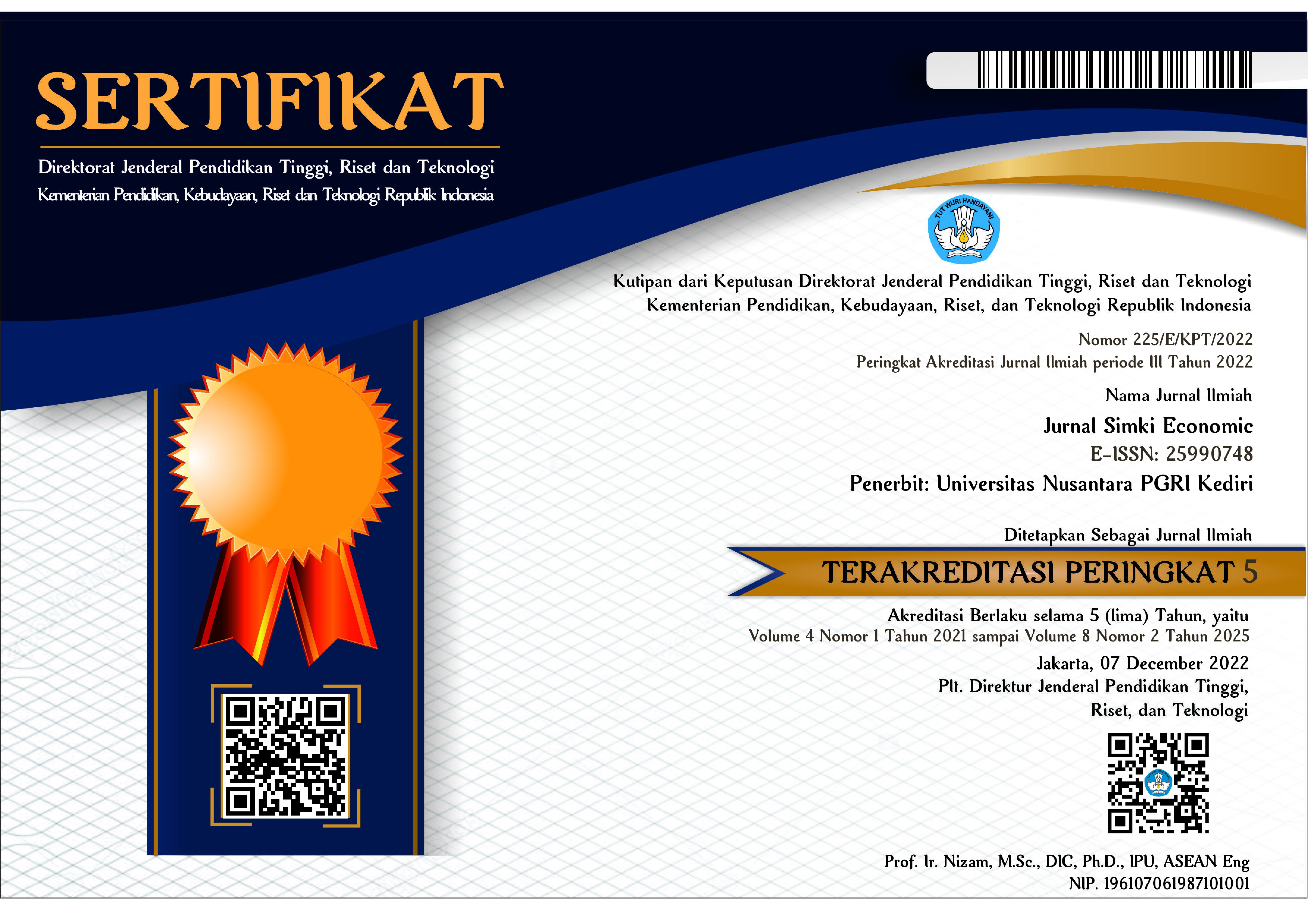Analisis Faktor-Faktor Yang Mempengaruhi Kemiskinan di Provinsi Jambi
 Abstract views: 583
,
Abstract views: 583
,
 PDF (Bahasa Indonesia) downloads: 961
PDF (Bahasa Indonesia) downloads: 961
Abstract
Local government policies are expected to overcome poverty problems in their regions. Regional development policies are aimed at overcoming the problem of poverty because poverty is an important problem that needs to be solved to support the success of economic development. This research is intended to determine the factors that influence poverty in Jambi Province, so that the results of this study can be used as a reference for the government to adopt policies in efforts to develop and improve the welfare of the people of Jambi Province. The research data uses secondary data obtained from sources from the Central Statistics Agency (BPS) from 2009 to 2019. The method used is a case study because this research consists of collecting data that supports one event raised. The tools used are inductive statistics and panel data regression. The results showed that the population variable had a positive and insignificant effect on the poverty rate, the unemployment variable had a negative but not significant effect on poverty, the economic growth variable had a negative and significant effect on poverty and the education variable had a positive and insignificant effect on poverty in Jambi Province in 2009 -2019.
Downloads
References
Alkire, S., & Santos, M. E. (2010). Acute Multidimensional Poverty: A New Index for Developing Countries. United Nations Development Programme, Human Development Reports Research Paper, 1–142. https://doi.org/10.2139/ssrn.1815243
Amalia, I. N., & Mahmudiono, T. (2017). Hubungan Pendapatan, Total Pengeluaran, Proporsi Pengeluaran Pangan dengan Status Ketahanan Rumah Tangga Petani Gurem (Studi di Desa Nogosari Kecamatan Rambipuji Kabupaten Jember). Amerta Nutrition, 1(2), 143. https://doi.org/10.20473/amnt.v1i2.6237
Azpitarte, F. (2011). Measurement and identification of asset-poor households: A cross-national comparison of Spain and the United Kingdom. Journal of Economic Inequality, 9(1), 87–110. https://doi.org/10.1007/s10888-010-9135-2
Bps. (2008). Analisis dan Perhitungan Tingkat Kemiskinan 2008. https://doi.org/Katalog BPS 3205015
Cao, M., Xu, D., Xie, F., Liu, E., & Liu, S. (2016). The influence factors analysis of households’ poverty vulnerability in southwest ethnic areas of China based on the hierarchical linear model: A case study of Liangshan Yi autonomous prefecture. Applied Geography, 66, 144–152. https://doi.org/10.1016/j.apgeog.2015.11.016
Gujarat, D. N., & Porter, D. C. (2009). Basic Econometrics Fifth Edition Damodar (F. Edition & Damodar (eds.); Fifth Edit). The McGraw-Hill Series Economics ESSENTIALS.
Kadek, A. N. (2013). Faktor-Faktor Yang Mempengaruhi Penduduk Lanjut Usia Masih Bekerja. Fakultas Ekonomi Dan Bisnis Universitas Udayana.
Kanbur, R., Chambers, R., Petesch, P., Uphoff, N., Ravallion, M., Bourguignon, F., Sahn, D., Moser, C., Barrett, C., Booth, D., Rao, V., Christiaensen, L., Hentschel, J., Shaffer, P., McGee, R., Herring, R., Fields, G., Wilks, A., & Thorbecke, E. (2001). Qualitative and quantitative poverty appraisal: complementarities, tensions and the way forward. Qualitative and Quantitative Poverty Appraisal: Complimentarities, Tensions and the Way Forward, 1–111. https://ecommons.cornell.edu/handle/1813/57691
Kasus, P., Perdesaan, D. I., Perkotaan, D. A. N., & Banyumas, K. A. B. (2012). Ketahanan Pangan Pada Rumah Tangga Miskin (Perbandingan Kasus Di Pedesaan Dan Perkotaan Kab. Banyumas) Neni. Http://Download.Portalgaruda.Org/Article.Php?Article=308361&Val=7323 Title=Ketahanan Pangan Pada Rumah Tangga Miskin (Perbandingan Kasus Di Pedesaan Dan Perkotaan Kab. Banyumas)
Knowles, S., & Owen, P. D. (1995). Health capital and cross-country variation in income per capita in the Mankiw-Romer-Weil model. Economics Letters, 48(1), 99–106. https://doi.org/10.1016/0165-1765(94)00577-O
Meier, G. M. (2000). The Old Generation of Development Economist and The New. In Frontier of Development Economist (The Future in Perspective) (Issue December).
Paizal, M., Sahrul, S., & Sukmawati, U. S. (2021). Analisis Indeks Pembangunan Manusia (Ipm) Terhadap Kemiskinan Di Kalimantan Barat. JIEF: Journal of Islamic Economics and Finance, 1(2), 41–51. https://doi.org/10.28918/jief.v1i2.4123
Perkotaan, K., Perdesaan, D. A. N., & Indonesia, D. I. (2010). Kepala Badan Pusat Statistik.
Sessu, A. (2018). Contribution of Products Domestic Bruto (GDP) Based on the Business Field on Poverty in Indonesia. World Journal of Business and Management, 4(1), 73. https://doi.org/10.5296/wjbm.v4i1.13265
Smith, S. C., & Todaro, M. P. (2012). The Developed and Developing World Income.
Suripto, & Subayil, L. (2020). Pengaruh Tingkat Pendidikan, Pengangguran, Pertumbuhan Ekonomi Dan Indeks Pembangunan Manusia Terhadap Kemiskinan Di D.I.Yogyakarta Periode 2010-2017. Jurnal Ilmiah Ekonomi Pembangunan, 1(2), 127.
Tambunan, T. (2012). Perekonomian Indonesia: Kajian Teoritis dan Analisis Empiris. Ghalia Indonesia.
Todaro, M. P., & Smith, S. C. (2011). Economic Development. In Economic Development.
Copyright (c) 2023 Suripto, Monica Dyah Angraini

This work is licensed under a Creative Commons Attribution 4.0 International License.














